Children, Vol. 12, Pages 831: The Impact of Physical Activity on Clinical Outcomes in Children with Cystic Fibrosis: A Narrative Review
Children doi: 10.3390/children12070831
Authors:
Chiara Rosolia Capasso
Antonio Luca Miniato
Paola Di Filippo
Armando Di Ludovico
Sabrina Di Pillo
Francesco Chiarelli
Giuseppe Francesco Sferrazza Papa
Marina Attanasi
Background: Cystic fibrosis (CF) is a chronic genetic disease marked by progressive lung function decline and increased respiratory infections. Emerging evidence supports the role of physical exercise in improving lung function, aerobic capacity, and quality of life in pediatric CF patients. Methods: We reviewed randomized clinical trials and observational studies from the last ten years, sourced from PubMed and Google Scholar. Included studies involved children and adolescents (0–18 years) with CF and assessed physical exercise as a primary intervention to improve lung function, aerobic fitness, quality of life, or hospitalization rates. Results: Aerobic training, particularly when combined with strength training, improves cardiorespiratory fitness and muscle strength without compromising nutritional status. High-Intensity Interval Training and Inspiratory Muscle Training show potential but need further validation. Supervised, personalized exercise programs are key to promoting adherence and optimizing outcomes. Conclusions: Exercise-based interventions in pediatric CF should evolve toward personalized, technology-enhanced, and sustainable models. Integrating wearable devices, adapting programs to individual needs, and leveraging early parental involvement may enhance engagement and outcomes, especially in the era of CFTR modulator therapies.
Source link
Chiara Rosolia Capasso www.mdpi.com


